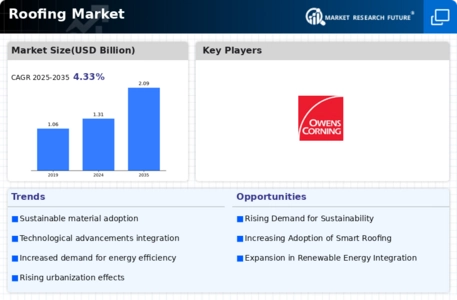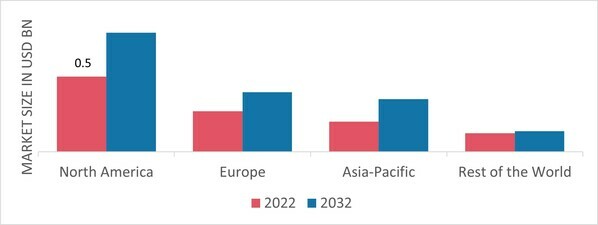Market Analysis
Roofing market (Global, 2024)
Introduction
Changing consumer preferences, technological advances and regulatory pressures are all reshaping the roofing market. In particular, a growing focus on energy-saving and sustainable development is leading to the introduction of more and more innovative roofing solutions, incorporating materials that not only enhance the life of the roof but also help to preserve the environment. Demand for roofing products is being driven by a number of factors, including the growth of the construction industry, the increasing need for the renovation and maintenance of existing buildings, and the growing awareness of the importance of climate-resilient construction. In response to the demand for high-quality roofs that offer long-term value, the market is now focusing on smart roof technology and eco-friendly materials. The changing landscape is both a challenge and an opportunity for manufacturers, suppliers and contractors, who must be able to respond quickly to the complexity of changing customer expectations and market trends.
PESTLE Analysis
- Political
- In 2024, the roofing market will be influenced by political factors such as government regulations and policies that promote sustainable building practices. The U.S. government, for example, has allocated $1.2 billion to the implementation of energy-efficient building codes, which directly affects the roofing materials and technology market. Local governments are also promoting the use of eco-friendly roofing solutions. In the U.S., more than 30 states have adopted legislation to encourage the use of solar roofing systems, which may change the market’s dynamics.
- Economic
- The economic conditions also affect the roofing market, especially the level of construction expenditure. In 2024, total construction expenditure in the United States is expected to reach $1.8 trillion, with residential construction representing about $900 billion of this figure. The expected rise in construction activity will stimulate the demand for roofing materials and services. In addition, the unemployment rate in the construction industry is estimated to be around 5%, which shows a relatively stable labour market that is favourable for the roofing industry.
- Social
- Social trends are increasingly influencing the tastes of the market in roofs. Surveys indicate that by 2024, more than two-thirds of owners of dwellings will be guided in the choice of materials by a concern for the environment. Furthermore, the trend towards improvement and renewal of dwellings continues, and some forty per cent of owners of dwellings intend to carry out roofing work in the coming year. Consequently, roof-covering companies are adapting their ranges of products to meet the demands for materials that are both eco-friendly and aesthetically pleasing.
- Technological
- The development of the roofing market is also being influenced by technological progress, especially with the development of smart roof solutions. By 2024 it is expected that approximately 25 per cent of all new roofs will be equipped with smart technology, for example sensors to monitor roof condition and energy consumption. Furthermore, the use of new roofing materials such as reflective coatings and solar shingles is growing. It is estimated that their use will increase by 15 per cent compared with previous years. These new materials not only improve performance but also fit in with the consumers’ preferences for energy-efficient solutions.
- Legal
- The legal factors are also important in determining the structure of the roofing market. In 2024, the implementation of the International Building Code (IBC) introduced stricter requirements for roofing materials, especially in areas exposed to extreme weather conditions. These regulations apply to half of the roofers, who have to adapt their practices to meet the new standards. The liability for roofing work is also becoming more stringent, with the result that the premiums for contractors' insurance are rising, which could affect their operating costs.
- Environmental
- In the roofing market, environmentalism is becoming more and more important, especially with the increasing importance of sustainability. In 2024, it is estimated that one in five roofing materials sold will be made of recycled material, which is in line with the shift towards a circular economy. Moreover, the roofing industry is under pressure to reduce its carbon footprint. By 2030, several NGOs have set a goal of reducing greenhouse gas emissions by at least 30 percent. Among other things, this has led to the development of more sustainable roofs, such as green roofs and cool roofs, which are increasingly popular among consumers with an environment-friendly attitude.
Porter's Five Forces
- Threat of New Entrants
- The roofing market in 2024 is under moderate threat from new entrants. The initial investment in equipment and materials can be considerable, but the market is attractive because of the steady demand for roofing services. However, established players enjoy the benefits of customer loyalty and established customer relationships, which may deter new players from entering the market.
- Bargaining Power of Suppliers
- The suppliers of roofing materials generally have little bargaining power. Suppliers of shingles, tiles, and metal sheets are numerous, and it is easy for the roofing contractors to change suppliers. Prices are generally stable.
- Bargaining Power of Buyers
- The buyers in the roofing market will be in a position of considerable strength in 2024. The number of different roofs and roofers will be numerous, and customers will be able to compare prices and services easily. In order to attract and retain customers, roofers will be forced to offer a wide range of products and services at a reasonable price.
- Threat of Substitutes
- The threat of substitutes in the roofing market is moderate. While the most widely used materials for roofing are asphalt shingles and metal sheets, other alternatives, such as green roofs and solar panels, are gaining in popularity. The unique benefits and proven performance of traditional materials, however, limit the immediate threat of substitutes.
- Competitive Rivalry
- In 2024 the competition for the roofing market will be intense. Contractors and companies will compete for market share, which will lead to aggressive price- and marketing strategies. In this crowded market it is crucial for companies to differentiate themselves by quality, service and innovation.
SWOT Analysis
Strengths
- Strong demand for roofing services due to increasing construction activities.
- Diverse range of roofing materials catering to various customer preferences.
- Technological advancements leading to improved roofing solutions and energy efficiency.
Weaknesses
- High competition leading to price wars and reduced profit margins.
- Seasonal fluctuations affecting demand and workforce availability.
- Dependence on weather conditions which can disrupt project timelines.
Opportunities
- Growing trend towards sustainable and eco-friendly roofing solutions.
- Expansion into emerging markets with rising construction needs.
- Increased investment in renovation and remodeling projects boosting roofing demand.
Threats
- Economic downturns potentially reducing construction budgets.
- Rising costs of raw materials impacting pricing strategies.
- Regulatory changes and compliance requirements increasing operational complexities.
Summary
In 2024, the roofing market will be characterized by a strong demand driven by construction activities and technological development, while facing the challenges of high competition and seasonal fluctuations. Opportunities include the growing preference for sustainable solutions and the expansion into new markets. Threats include the upcoming uncertainty and rising material costs. The companies should exploit their strengths to maintain their competitiveness by innovating and adapting to the market.




Leave a Comment